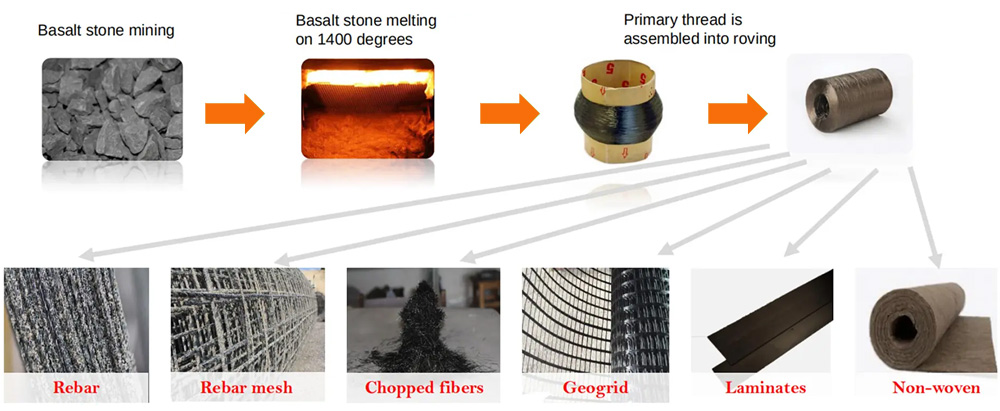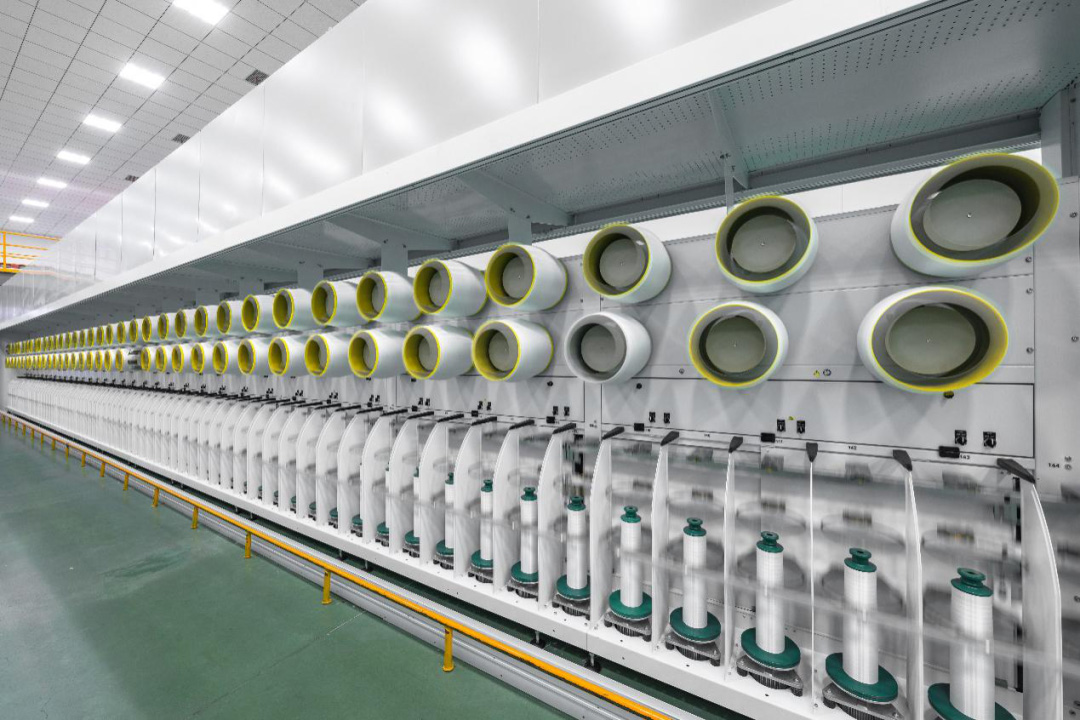Basalt Fiber
Basalt fiber is a continuous fiber drawn from natural basalt. It is basalt stone in 1450 ℃ ~ 1500 ℃ after melting, through the platinum-rhodium alloy wire drawing leakage plate high-speed pulling made of continuous fiber. The color of pure natural basalt fiber is generally brown. Basalt fiber is a new type of inorganic environmentally friendly green high-performance fiber material, which is composed of silica, alumina, calcium oxide, magnesium oxide, iron oxide and titanium dioxide and other oxides. Basalt continuous fiber not only has high strength, but also has a variety of excellent properties such as electrical insulation, corrosion resistance, high temperature resistance and so on. In addition, the production process of basalt fiber decided to produce less waste, small pollution to the environment, and the product can be directly degraded in the environment after the waste, without any harm, so it is a real green, environmentally friendly materials. Basalt continuous fibers have been widely used in fiber-reinforced composites, friction materials, shipbuilding materials, heat-insulating materials, the automotive industry, high-temperature filtration fabrics, and protective fields.
Characteristics
① Sufficient raw materials
Basalt fiber is made of basalt ore melted and drawn, and basalt ore on the Earth and the moon are quite objective reserves, from the raw material costs are relatively low.
② Environmentally friendly material
Basalt ore is a natural material, no boron or other alkali metal oxides discharged during the production process, so there is no harmful substances precipitated in the smoke, the atmosphere will not cause pollution. Moreover, the product has a long life, so it is a new type of green active environmental protection material with low cost, high performance and ideal cleanliness.
③ High temperature and water resistance
Continuous basalt fiber working temperature range is generally 269 ~ 700 ℃ (softening point of 960 ℃), while the glass fiber for a 60 ~ 450 ℃, the highest temperature of carbon fiber can only reach 500 ℃. In particular, basalt fiber in 600 ℃ work, its strength after the break can still maintain 80% of the original strength; work at 860 ℃ without shrinkage, even if the temperature resistance of excellent mineral wool at this time after the break can only be maintained at 50% -60%, glass wool is completely destroyed. Carbon fiber at about 300 ℃ on the CO and CO2 production. Basalt fiber at 70 ℃ under the action of hot water can maintain high strength, basalt fiber in 1200 h may lose part of the strength .
④ Good chemical stability and corrosion resistance
Continuous basalt fiber contains K2O, MgO) and TiO2 and other components, and these components to improve the chemical corrosion resistance of the fiber and waterproof performance is extremely beneficial, play a fairly important role. It is more advantageous compared with the chemical stability of glass fibers, especially in alkaline and acidic media more obvious basalt fibers in saturated Ca (OH) 2 solution and cement and other alkaline media can also maintain a higher resistance to alkali corrosion performance.
⑤ High modulus of elasticity and tensile strength
The modulus of elasticity of basalt fiber is 9100 kg/mm-11000 kg/mm, which is higher than that of alkali-free glass fiber, asbestos, aramid fiber, polypropylene fiber and silica fiber. The tensile strength of basalt fiber is 3800–4800 MPa, which is higher than that of large tow carbon fiber, aramid fiber, PBI fiber, steel fiber, boron fiber, alumina fiber, and is comparable with S glass fiber. Basalt fiber has a density of 2.65-3.00 g/cm3 and a high hardness of 5-9 degrees on the Mohs hardness scale, thus it has excellent abrasion resistance and tensile reinforcement properties. Its mechanical strength far exceeds that of natural fibers and synthetic fibers, so it is an ideal reinforcing material, and its excellent mechanical properties are at the forefront of the four major high-performance fibers.
⑥ Outstanding sound insulation performance
Continuous basalt fiber has excellent sound insulation, sound absorption performance, from the fiber in different audio sound absorption coefficient can be learned, with the increase in frequency, its sound absorption coefficient increases significantly. Such as the selection of diameter 1-3μm basalt fiber made of (density of 15 kg/m3, thickness of 30mm) sound-absorbing materials, in the audio for the 100-300 Hz, 400-900 Hz and 1200-7,000 HZ conditions, the fiber material absorption coefficient of 0.05~0.15, 0.22~0.75 and 0.85~0.93, respectively.
⑦ Outstanding dielectric properties
The volume resistivity of continuous basalt fiber is one order of magnitude higher than that of E glass fiber, which has excellent dielectric properties. Although the basalt ore contains a mass fraction of nearly 0.2 of the conductive oxides, but the use of special infiltrating agent special surface treatment, the basalt fiber dielectric consumption angle tangent than the glass fiber is 50% lower, the volume resistivity of the fiber is also higher than the glass fiber
⑧ Natural silicate compatibility
Good dispersion with cement and concrete, strong bonding, consistent coefficient of thermal expansion and contraction, good weather resistance.
⑨ Lower moisture absorption
The moisture absorption of basalt fiber is less than 0.1%, lower than aramid fiber, rock wool and asbestos.
⑩ Lower thermal conductivity
The thermal conductivity of basalt fiber is 0.031 W/m-K – 0.038 W/m-K, which is lower than that of aramid fiber, alumino-silicate fiber, alkali-free glass fiber, rockwool, silicon fiber, carbon fiber and stainless steel.
Fiberglass
Fiberglass, an inorganic non-metallic material with excellent performance, has a wide variety of advantages such as good insulation, heat resistance, good corrosion resistance, high mechanical strength, but the disadvantage is brittle and poor abrasion resistance. It is based on chlorite, quartz sand, limestone, dolomite, boron calcium stone, boron magnesium stone six kinds of ores as raw materials by high-temperature melting, drawing, winding, weaving and other processes into the manufacture of the diameter of its monofilament for a few microns to more than 20 microns, equivalent to a hair of 1/20-1/5, each bundle of fiber filaments are hundreds or even thousands of monofilament composition. Fiberglass is usually used as reinforcing materials in composite materials, electrical insulation materials and thermal insulation materials, circuit boards and other areas of the national economy.
Material Properties
Melting point: glass is a kind of non-crystalline, no fixed melting point, it is generally believed that the softening point of 500 ~ 750 ℃.
Boiling point: about 1000 ℃
Density: 2.4~2.76 g/cm3
When glass fiber is used as reinforcing material for reinforced plastics, the biggest feature is its high tensile strength. Tensile strength in the standard state is 6.3 ~ 6.9 g / d, wet state 5.4 ~ 5.8 g / d. Heat resistance is good, the temperature up to 300 ℃ on the strength of no effect. It has excellent electrical insulation, is a high-level electrical insulation materials, also used for insulation materials and fire shielding materials. Generally only corroded by concentrated alkali, hydrofluoric acid and concentrated phosphoric acid.
Main Features
(1) High tensile strength, small elongation (3%).
(2) High coefficient of elasticity, good rigidity.
(3) Elongation within the limits of elasticity and high tensile strength, so it absorbs large impact energy.
(4) Inorganic fiber, non-combustible, good chemical resistance.
(5) Small water absorption.
(6) Good scale stability and heat resistance.
(7) Good processability, can be made into strands, bundles, felts, fabrics and other different forms of products.
(8) Transparent and light transmittable.
(9) Good adhesion with resin.
(10) Inexpensive.
(11) Not easy to burn, can be fused into glassy beads at high temperature.
Post time: Apr-11-2024



